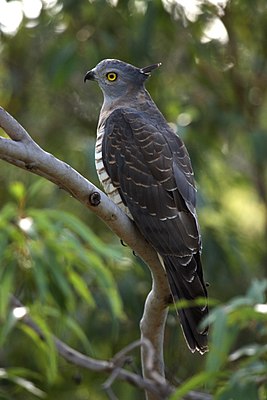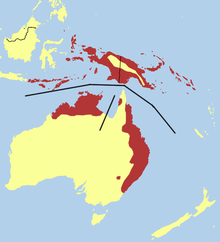Papua Christmas
| Papua Christmas | ||||||||||
|---|---|---|---|---|---|---|---|---|---|---|

Papua Christmas |
||||||||||
| Systematics | ||||||||||
|
||||||||||
| Scientific name | ||||||||||
| Aviceda subcristata | ||||||||||
| ( Gould , 1838) |
The Papuan Weih ( Aviceda subcristata ) is a comparatively small bird of prey from the subfamily of the honey buzzards (Perninae), which is native to New Guinea and Australia. The very contrasting black-white-maroon patterned species feeds mainly on large insects and colonizes open areas in subtropical and tropical forests of the hill country. During the breeding season it is shy and lives solitary or in pairs. Outside the breeding season, loose groups of 30 to 40 individuals can occur.
The IUCN classifies the stock situation of the Papuaweih as safe ( least concern ). There are 13 subspecies.
features
The Papuaweih reaches a body length of 35 to 45 centimeters and has a wingspan of 80 to 110 centimeters. Males weigh an average of 300 grams, the females are slightly heavier at 340 grams. On the pigeon-like head there is a long feather hood, which is often raised or moved up and down when sitting, but is put on when in flight.
Adult birds
Adult Papuan harriers have a light gray neck and head. The spring bonnet is slate gray to black with a white spring base. The coat is silver-gray and clearly stands out from the dark wing-covers. The back, rump and upper tail-coverts as well as the tail plumage are blue-gray. The tail plumage also has a broad black end band. The underside of the body is light gray from the chin to the lower chest, but in many individuals the throat area is slightly reddish-brown. In the case of Papuan harriers shortly before moulting, the chin can also appear whitish due to the wear and tear of the plumage. The belly, the flanks and the thighs are whitish to creamy white with a conspicuously reddish brown to blackish brown transverse banding. The lower legs, the rump and the under tail-coverts are light reddish brown.
The beak is dark gray to black, the iris is yellow, and the legs and feet are blue-gray to whitish or light yellow.
Fledglings
In juveniles, the vertex and the bonnet are still dark brown. The white feather base is often clearly visible and forms a white spot on the back of the head. Noticeable is a short white stripe that is missing in the adult birds. The top of the body looks scaled due to the reddish-brown feather hems. The tail plumage has three darker transverse bands. The chin and throat are whitish, the rest of the underside of the body is creamy white with a denser dark brown transverse banding than in the adult birds.
Possible confusion
The Papua Weih is not to be confused with any other Australian bird of prey due to its feather bonnet and its cross-banded underside of the body. However, it shares these characteristics with the hooded fruit pigeon , which, however, is larger than the Papuan Weih. The bands Habicht ( Accipiter fasciatus ) and the Sydney Sperber ( Accipiter cirrocephalus ) are somewhat finer quergebändert on the body bottom, which is less noticeable in field observations as well.
distribution and habitat
The Papuan Weih is a bird of prey found in tropical and subtropical forests in New Guinea and in the north and east of Australia. The altitude distribution in Australia is not known. In New Guinea it usually occurs below 1,300 meters above sea level. Occasionally, however, it has also been spotted at altitudes of 1700 meters. Little research has been done into the migratory behavior of the Papuaweih. It is probably a resident bird in large parts of its distribution area .
The Handbook of the Birds of the World distinguishes between the following subspecies:
- A. s. rufa (Schlegel, 1866) - Occurrence on islands in the north of the Moluccas .
- A. s. stresemanni (Siebers, 1930) - Occurrence is the Buru , a heavily forested Indonesian island that belongs to the Moluccas archipelago.
- A. s. reinwardtii (Schlegel & S. Müller, 1841) - Occurrence is Seram , the second largest island in the Moluccas archipelago and the islands off their coast (Boana, Ambon and Haruku).
- A. s. timorlaoensis (AB Meyer, 1893) - occurrence on islands in the Flores Sea
- A. s. pallida (Stresemann, 1913) - Occurrence on islands in the south of the Moluccas
- A. s. waigeuensis Mayr, 1940 - Occurrence on the island of Waigeo off the coast of New Guinea.
- A. s. stenozona (GR Gray, 1858) - Occurrence on the island of Misool off the coast of western New Guinea and lowlands in western and southern New Guinea and on the Aru Islands .
- A. s. obscura boy, 1956 - Occurrence on Blak Island in Cenderawasih Bay .
- A. s. me gala (Stresemann, 1913) - Occurrence in the lowlands in the north and east of New Guinea. The Yapen in the Cenderawasih Bay and the D'Entrecasteaux Islands in the Solomon Sea also belong to the distribution area .
- A. s. coultasi Mayr, 1945 - Occurrence on the Admiralty Islands northeast of New Guinea.
- A. s. bismarckii (Sharpe, 1888) - Occurrence in the east of the Bismarck Archipelago .
- A. s. gurneyi (EP Ramsay, 1882) - found in the Solomon Islands
- A. s. subcristata (Gould, 1838) - the nominate form occurs in the north and east of Australia.
Outside the breeding season, it can often be observed in forest regions with logging as well as in parks and gardens in suburbs. Occasionally it is on the ground, but usually it sits in trees. Due to his hunting style, he has benefited from partial logging in previously dense forests. It has therefore been able to expand its range in New Guinea. However, where forests are completely cut down in favor of agricultural land, he no longer finds a suitable habitat.
food
The Papuan Weih is an omnivore. However, especially during the breeding season, it mainly covers its food needs with ghosts . It also eats other insects and their larvae, as well as small vertebrates. This includes mainly tree frogs, but also snakes, lizards, nestlings and smaller bird species as well as lizards and fruits such as figs. Sometimes it hangs upside down from branches to get to fruit. He kills lizards and frogs by biting through the skull.
The Papuan Weih spies out its prey in the forest from well-hidden hide guards. During his fishing flights he usually stays below the treetops or he undertakes search flights just above the treetops. Dense forests are not very suitable for this hunting technique. Accordingly, it hunts more at the edges of the forest, in forest clearings, along rocky slopes lined with trees and along watercourses and roads. It is said of him that he imitates the calling of the tree frogs in order to initiate a response from the frogs and in this way to find them in the foliage.
Reproduction
The breeding season falls from October to February. Eggs were found in the Australian state of Queensland as early as mid-September. The nestlings usually fledge from early November to mid-February. There is no evidence that they raise more than one clutch in a breeding season. However, they seem to lay a second clutch if the first is lost.
Papuan harriers show a very conspicuous courtship flight. To do this, they rise very steeply into the air with powerful wing beats, with the tips of the wings almost touching each other over the back, and then, with V-shaped wings, they can be arched down again and then glided up, to then repeat the sequence. With these elements, the courtship flight is somewhat similar to that of the wood pigeon . The function of the courtship flight, which is accompanied by loud shouts, is either to re-establish a pair bond for the first time or to renew it. Other courtship acts are mutual nibbling of feathers and the transfer of food by the male to the female.

The Papuan Weih usually nests in wooded areas along rivers or streams. As far as we know, he is monogamous. Observations, especially in Australia, suggest that a couple defends a territory all year round. The nest is cup-shaped and is built from twigs and twigs and covered with fresh eucalyptus leaves. The outer diameter of the nest is 25 to 40 centimeters, the height is between 12 and 15 centimeters. The nest bowl is four to five centimeters deep. In exceptional cases, the nests are also significantly larger: A nest was found that had a diameter of one meter and a height of 75 centimeters. Both parent birds are involved in building the nest. They tear branches from the trees by falling upside down and flapping their wings. The torn branch is then carried to a stand guard near the nesting site and some of the leaves are torn off with the beak. Leaves, with which the interior of the nest is laid out, are carried by the parent birds during the entire breeding and nestling season. The nests usually only last one breeding season and are mainly destroyed by wind.
The clutch size has not yet been conclusively investigated, however, clutches usually appear to consist of two to three eggs. Both parent birds breed, but the females have a slightly larger proportion. Papuan hares held in captivity had a breeding time of 29 days, while Papuan hares in the wild have been observed for 33 days. The nestlings hatch asynchronously, the eggshells are removed from the nest by the parent birds. The nestlings are fed and flocked by both parent birds. On hot days, the parent birds stand over the nest with outspread wings in order to shade the nestlings. The nestling period is 32 to 35 days. There is still no data on how long the young birds will be cared for by the parent birds after they have fled.
Trivia
Both breeding females of the gray bower and males in the vicinity of their arbor imitate the calls of the Papuan Weih, which are among their predators.
Papua Weih and humans
The Papua Weih is also said to stalk domestic chickens and beat them.
literature
- James Ferguson-Lees , David A. Christie: Raptors of the World. Helm Identification Guides, Christopher Helm, London 2001, ISBN 0-7136-8026-1 .
- PJ Higgins (Ed.): Handbook of Australian, New Zealand & Antarctic Birds , Volume 2, Raptors to Lapwings, Oxford University Press, Oxford 1993, ISBN 0-19-553069-1 .
Web links
Single receipts
- ↑ a b c Higgins (Ed.): Handbook of Australian, New Zealand & Antarctic Birds . Volume 2, p. 27.
- ↑ a b c Handbook of the Birds of the World for Papua Weih | , accessed on April 29, 2017
- ↑ a b Higgins (Ed.): Handbook of Australian, New Zealand & Antarctic Birds . Volume 2, p. 26.
- ↑ a b c Higgins (Ed.): Handbook of Australian, New Zealand & Antarctic Birds . Volume 2, p. 28.
- ↑ a b c Higgins (Ed.): Handbook of Australian, New Zealand & Antarctic Birds . Volume 2, p. 29.
- ↑ Higgins (Ed.): Handbook of Australian, New Zealand & Antarctic Birds . Volume 2, p. 31.
- ↑ a b c d Higgins (Ed.): Handbook of Australian, New Zealand & Antarctic Birds . Volume 2, p. 32.
- ↑ Higgins (Ed.): Handbook of Australian, New Zealand & Antarctic Birds . Volume 2, p. 30.
- ↑ Clifford B. Frith, Dawn. W. Frith: The Bowerbirds - Ptilonorhynchidae . Oxford University Press, Oxford 2004, ISBN 0-19-854844-3 . P. 427


